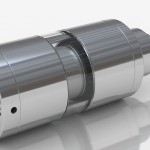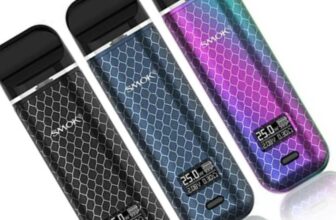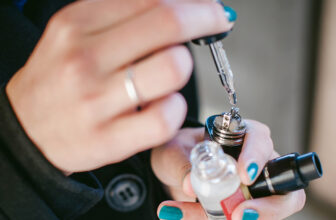
It has been brought up to me that many viewers are still having trouble understanding what each attachment is called. And, even some of you know the names or have heard of them, yet can’t place them with the right attachment. To clear things up, we’re going to list each attachments name, explain what it is and include a picture to remove any confusion you may have. It may seem like I’m beating a dead horse writing posts like this being that I’ve already published posts answering what a clearomizer is, what a cartomizer is and so on, but maybe it’ll help others if we place all this information on one post.
1. Atomizer
 This type of atomizer is the original “atomizer”. Though it’s referred to simply as an atomizer, most who reminisce of the times when it was used now refer to it as a standard atomizer or disposable atomizer. The way it works is quite simple… the metal tube held the wick and coil. The user would drip e-liquid onto the coil directly (much like we do with rebuildable atomizers today) and air would travel through the bottom on the 510 connection, and up into the atomizer. The problem with the first atomizer was that it leaked outrageously. In fact, it leaked so bad that companies invented the “drip shield” to catch the e-liquid that would leak out. After this era in vaping, it was a steady uphill improvement on the attachments we use with our devices.
This type of atomizer is the original “atomizer”. Though it’s referred to simply as an atomizer, most who reminisce of the times when it was used now refer to it as a standard atomizer or disposable atomizer. The way it works is quite simple… the metal tube held the wick and coil. The user would drip e-liquid onto the coil directly (much like we do with rebuildable atomizers today) and air would travel through the bottom on the 510 connection, and up into the atomizer. The problem with the first atomizer was that it leaked outrageously. In fact, it leaked so bad that companies invented the “drip shield” to catch the e-liquid that would leak out. After this era in vaping, it was a steady uphill improvement on the attachments we use with our devices.
2. Cartomizer
 The cartomizer is a lot like the original atomizer, except that it had a longer metal tube body. The extra length came from the need of space so that the manufacturer could insert a wicking material to the top of the body. How this worked was, users would drip e-liquid into the top and onto the wicking material. The wicking material was used to store e-liquid, and it would then slowly drip onto the wick and coil at the bottom of the cartomizer. When users would pull from the top of the cartomizer, air would make its way through the air holes on the 510 connection at the bottom of the cartomizer. The issue with the cartomizer is that the wicking material couldn’t continue feeding the appropriate amount of e-liquid to the coil, thus causing dry hits. In addition, quality control at this time for manufacturers wasn’t what it is today, so many of the cartomizers would come DOA (dead on arrival).
The cartomizer is a lot like the original atomizer, except that it had a longer metal tube body. The extra length came from the need of space so that the manufacturer could insert a wicking material to the top of the body. How this worked was, users would drip e-liquid into the top and onto the wicking material. The wicking material was used to store e-liquid, and it would then slowly drip onto the wick and coil at the bottom of the cartomizer. When users would pull from the top of the cartomizer, air would make its way through the air holes on the 510 connection at the bottom of the cartomizer. The issue with the cartomizer is that the wicking material couldn’t continue feeding the appropriate amount of e-liquid to the coil, thus causing dry hits. In addition, quality control at this time for manufacturers wasn’t what it is today, so many of the cartomizers would come DOA (dead on arrival).
3. Cartomizer Tank
 The cartomizer tank was invented so that the users who craved an increase e-liquid storage could have an attachment. By this, the same cartomizer was used, but users or the manufacturer would poke holes into the side of the cartomizer towards the bottom. A tank would then slide onto and around the cartomizer tube. To avoid any e-liquid from leaking, the tank portion came with rubber o-rings on each end to seal the tank onto the cartomizer. Again, the issue with this still remained with the cartomizer and its inability to wick properly, and not to mention there were a lot of e-liquid spills from the way the cartomizer tank was designed.
The cartomizer tank was invented so that the users who craved an increase e-liquid storage could have an attachment. By this, the same cartomizer was used, but users or the manufacturer would poke holes into the side of the cartomizer towards the bottom. A tank would then slide onto and around the cartomizer tube. To avoid any e-liquid from leaking, the tank portion came with rubber o-rings on each end to seal the tank onto the cartomizer. Again, the issue with this still remained with the cartomizer and its inability to wick properly, and not to mention there were a lot of e-liquid spills from the way the cartomizer tank was designed.
4. Clearomizer
 To escape the burden of cartomizer tanks, the clearomizer was invented. The clearomizer was first invented where it mimicked the cartomizer, except that it was clear. Many referred to this first clearomizer as a clear cartomizer. Next came the same cartomizer designed, except that it didn’t have the filler wicking material typically found in a cartomizer. At this time users started putting the name “clear cartomizer” together and adopted the name “clearomizer”. From this point on clearomizers continued to progress in design, as well as performance, but really hit a turn when manufacturers introduced the first bottom coil clearomizer. Obviously, this design had the coil placed at the bottom of the clearomizer, allowing gravity to feed the e-liquid onto the wick, rather than the way a top coil clearomizer was designed, which forced the wick to hang down to the e-liquid and do all the work of wicking itself. Clearomizers have continued to improve, and its most recent change has been replacement coils that enter sub-ohm territory, which has become a popular form of vaping.
To escape the burden of cartomizer tanks, the clearomizer was invented. The clearomizer was first invented where it mimicked the cartomizer, except that it was clear. Many referred to this first clearomizer as a clear cartomizer. Next came the same cartomizer designed, except that it didn’t have the filler wicking material typically found in a cartomizer. At this time users started putting the name “clear cartomizer” together and adopted the name “clearomizer”. From this point on clearomizers continued to progress in design, as well as performance, but really hit a turn when manufacturers introduced the first bottom coil clearomizer. Obviously, this design had the coil placed at the bottom of the clearomizer, allowing gravity to feed the e-liquid onto the wick, rather than the way a top coil clearomizer was designed, which forced the wick to hang down to the e-liquid and do all the work of wicking itself. Clearomizers have continued to improve, and its most recent change has been replacement coils that enter sub-ohm territory, which has become a popular form of vaping.
5. Hybrid Tank
 The Hybrid Tank was introduced by Kanger, and at a time where sub-ohm vaping from clearomizers have become very popular. A hybrid tank as some call it, is a clearomizer that has the option to be used as a normal clearomizer with replacement pre-build coil heads or a rebuildable atomizer deck that will replace the coil head. This RBA deck gives the user the ability to build coils themselves and insert it onto the deck, and use that RBA section instead of those pre-built coil heads made by the manufacturer. This moment in the market of attachments was a huge leap and has become one of the most used type of attachments at this current time.
The Hybrid Tank was introduced by Kanger, and at a time where sub-ohm vaping from clearomizers have become very popular. A hybrid tank as some call it, is a clearomizer that has the option to be used as a normal clearomizer with replacement pre-build coil heads or a rebuildable atomizer deck that will replace the coil head. This RBA deck gives the user the ability to build coils themselves and insert it onto the deck, and use that RBA section instead of those pre-built coil heads made by the manufacturer. This moment in the market of attachments was a huge leap and has become one of the most used type of attachments at this current time.
6. Rebuildable Tank Atomizer
 The rebuildable tank atomizer came along just after the start of the clearomizers initial hype. It didn’t gain traction quickly, but soon became an “elite” form of vaping as time passed. The rebuildable tank atomizer adopted the reasons of why the clearomizer was invented, but also was designed to give users the ability to build their own coils, which gave them more freedom in vaping, as well as reducing the cost of vaping too. The first type of rebuildable tank atomizer was the top coil design, which acted much like the clearomizers beginning. Just like the clearomizer again, the rebuildable tank atomizer was redesigned and improved upon as the coil placement moved to the bottom of the attachment. The rebuildable tank atomizers today are designed a lot like today’s clearomizers, except that it has a deck that can be rebuilt rather than replacement coil that you screw on. There are of course more details into the design, but you get the midst of how it is designed and operated.
The rebuildable tank atomizer came along just after the start of the clearomizers initial hype. It didn’t gain traction quickly, but soon became an “elite” form of vaping as time passed. The rebuildable tank atomizer adopted the reasons of why the clearomizer was invented, but also was designed to give users the ability to build their own coils, which gave them more freedom in vaping, as well as reducing the cost of vaping too. The first type of rebuildable tank atomizer was the top coil design, which acted much like the clearomizers beginning. Just like the clearomizer again, the rebuildable tank atomizer was redesigned and improved upon as the coil placement moved to the bottom of the attachment. The rebuildable tank atomizers today are designed a lot like today’s clearomizers, except that it has a deck that can be rebuilt rather than replacement coil that you screw on. There are of course more details into the design, but you get the midst of how it is designed and operated.
7. Rebuildable Dripping Atomizer
 A rebuildable dripping atomizer came about not long after the rebuildable tank atomizer. Most vapers call it an RDA for short and some call it a dripper. The RDA is possibly the most simplest form of attachments, in that it has just a base and a deck that is milled from the same block of metal. The deck holds a positive post and negative post(s), similar to a rebuildable tank atomizer. However, the RDA’s deck space is larger and gives users the room to insert larger coils and much more wicking material to fill the space. Covering the deck is a cap and above that cap is a hole cut out to allow for a drip tip or a wide bore cap.
A rebuildable dripping atomizer came about not long after the rebuildable tank atomizer. Most vapers call it an RDA for short and some call it a dripper. The RDA is possibly the most simplest form of attachments, in that it has just a base and a deck that is milled from the same block of metal. The deck holds a positive post and negative post(s), similar to a rebuildable tank atomizer. However, the RDA’s deck space is larger and gives users the room to insert larger coils and much more wicking material to fill the space. Covering the deck is a cap and above that cap is a hole cut out to allow for a drip tip or a wide bore cap.









And now Aspire has come out with a build deck for their Atlantis lines. I am looking into scooping one up to maybe run some nickel builds on. I love both the Kanger Subtank series, “as I have all of them”and the Aspire Atlantis, v1 & v2. Ready to try the build deck on these as well. Great informative article Blake! Keep up the good work!!
Thanks homie!
I think the term hybrid tank is misleading. A hybrid device – with or without a tank – is a device that combines battery and atomizer without a connector.
I agree… it’s just the term I’ve seen most.